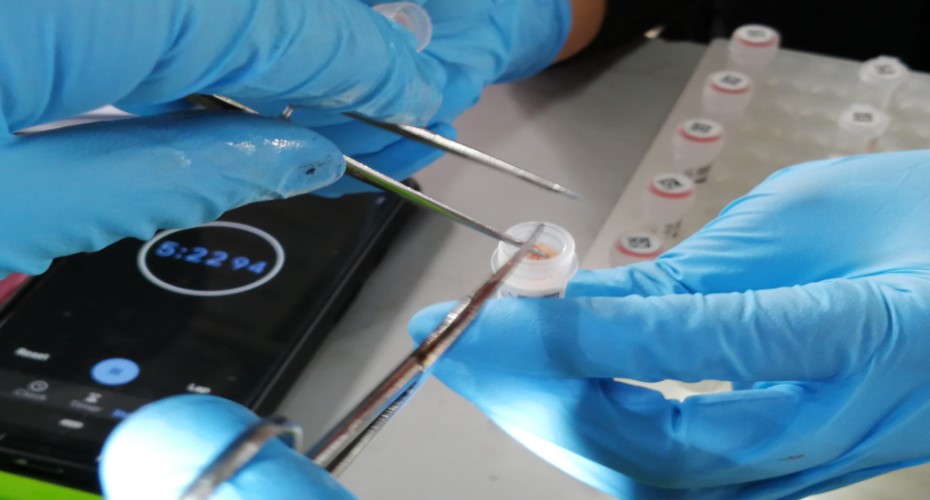Quick Fish Sampling Guides for Disease Diagnostics
Quick Fish Sampling Guides for Disease Diagnostics
Infectious diseases represent a major challenge and limitation to sustainable aquaculture
They can have major impacts on animal welfare, the livelihood of farmers, and threaten the health of captive stocks and wild populations. Pathogens can spread through movement of live fish, fish products, water and shared equipment. Routine screenings of pathogens in aquatic animal production systems are important to minimize the risk of their introduction, transmission and spread.
On suspicion of a disease during abnormal mortalities, investigation with collection of biological samples from moribund animals must take place rapidly for disease diagnostics. Quality biological sampling is a fundamental requirement for all kinds of disease diagnostic and pathogen screening work.
WorldFish and partners developed these rapid sampling guides to support high quality diagnostic and screening protocols. The guides can be printed and laminated for use in the field. They aim to provide end users with quick visual step-by-step instructions and requirements to collect biological samples for different diagnostic techniques:
Click on the individual tabs below to download and see each sampling guide in more detail.
WorldFish developed these guides in partnership with
- Centre for Environment Fisheries and Aquaculture Science (link)
- University of Exeter Sustainable Aquaculture Futures (link)
- Centre of Excellence for Shrimp Molecular Biology and Biotechnology (Centex Shrimp) (link)
- Norwegian Veterinary Institute (link)
- The University of Queensland (link)
- Mississippi State University (link)
- University of Ibadan (link)
Acknowledgments: This work was undertaken as part of the CGIAR Research Program on Fish Agri-Food Systems (FISH) led by WorldFish, the CGIAR Inspire Challenge 2019 project on Rapid Genomic Detection of Aquaculture Pathogens and the Feed the Future Innovation Lab for Fish project on Improving Biosecurity: A Science-Based Approach to Manage Fish Disease Risks and Increase the Socioeconomic Contribution of the Nigerian Catfish and Tilapia Industries. FISH is supported by contributors to the CGIAR Trust Fund.
This guide lists all the personal protective equipment, the data collection/recording/cleaning supplies and sampling materials: consumables, reagents, media and tools, needed to conduct one of the six quick fish-sampling guides for disease diagnostics outlined below.
Access via WorldFish repository: https://hdl.handle.net/20.500.12348/4836
Screening for parasitic and fungal infestations in production systems is important to minimize the risk of their introduction, transmission and spread. This quick guide is for the assessment of ectoparasites and fungi under a light compound microscope. Standard wet-mount specimens consist of gill biopsy (gill clip), fin biopsy (fin clip) and skin scraping (mucus smears). Additional smears may be included in the presence of external lesions/ulcers (eye, skin, mouth).
Access via WorldFish repository: https://hdl.handle.net/20.500.12348/4837
Interactions between microbes associated with the host, other organisms present in the system and the environment itself are increasingly recognised to contribute to aquatic animal diseases. Microbiome assemblages and their functions are extremely diverse and poorly understood. They vary over time in water and between host tissues and organs. High-throughput sequencing and bioinformatics analysis of complex microbiomes can provide biological insights offering new opportunities for early detection of pathogens and disease mitigation strategies.
This quick guide is for microbiome sampling from fish skin or gill mucus swabs, internal organs (e.g. gut) and water samples from ponds, hatcheries, tanks, river and canal water etc.
Access via WorldFish repository: https://hdl.handle.net/20.500.12348/4838
Fish blood sampling requires specific techniques and skills that are fundamental for all kinds of analyses such as haematology, chemistry analysis, parasitology/bacteriology investigation, antibody titration, molecular diagnostic and many others. This quick guide on blood sampling from fish is for blood serum isolation, blood plasma isolation, blood DNA extraction, blood RNA extraction, or for blood smear preparation on microscope slides.
Access via WorldFish repository: https://hdl.handle.net/20.500.12348/4839
Routine screening for bacterial pathogens are important to minimize their introduction into production systems, before they can cause serious diseases and spread to new areas. During an abnormal mortality event, routine sampling for bacteriology from moribund animals should take place rapidly as part of the disease diagnostic investigation. Bacteriology is the culture and identification of bacteria growing under specific conditions. This quick guide is for taking a standard bacteriology swab from the caudal or anterior kidney to inoculate onto agar to screen for systemic bacterial infection. Additional swabs may be included in the presence of external or internal lesions/ulcers (e.g. eye, skin, mouth, liver, spleen, brain).
Access via WorldFish repository: https://hdl.handle.net/20.500.12348/484
Routine health checks for key priority pathogens are important to minimize the risk of their introduction, transmission and spread. Molecular diagnostics are techniques used to amplify small DNA/RNA sequence(s) that are unique to a particular pathogen to ascertain their presence or absence. This quick guide is for taking standard specimens for general molecular and virology health evaluation, including kidney, liver, spleen, brain and gills. Other tissues may be collected.
Access via WorldFish repository: https://hdl.handle.net/20.500.12348/4841
Histology is the preparation of thin, stained tissue sections for microscopic examination to study their structure and function. Disease and disease processes can be studied by looking at changes in the anatomy or anomalies of cells, tissues and organs. This quick guide is for taking standard biopsy specimens for histological examination of fixed sections of brain, gill, heart, intestine, kidney, liver and spleen. Other tissues may be collected in the presence of external lesions/ulcers (e.g., eye, skin, muscle).
Access via WorldFish repository: https://hdl.handle.net/20.500.12348/4842


